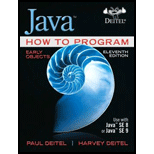
Concept explainers
(Target-Heart-Rate Calculator) While exercising, you can use a heart-rate monitor to see that your heart rate stays within a safe range suggested by your trainers and doctors. According to the American Heart Association (AHA) (http://bit.ly/TargetHeartRates), the formula for calculating your maximum heart rate in beats per minute is 220 minus your age in years. Your target heart rate is a range that’s 50-85% of your maximum heart rate. [Note: These formulas are estimates provided by the AHA. Maximum and target heart rates may vary based on the health, fitness and gender of the individual. Always consult a physician or qualified health-care professional before beginning or modifying an exercise program.] Create a class called HeartRates. The class attributes should include the person’s first name, last name and date of birth (consisting of separate attributes for the month, day and year of birth). Your class should have a constructor that receives this data as parameters. For each attribute provide set and get methods. The class also should include a method that calculates and returns the person’s age (in years), a method that calculates and returns the person’s maximum heart rate and a method that calculates and returns the person’s target heart rate. Write a Java app that prompts for the person’s information, instantiates an object of class HeartRates and prints the information from that object —including the person’s first name, last name and date of birth—then calculates and prints the person’s age in (years), maximum heart rate and target-heart-rate range.
Trending nowThis is a popular solution!

Chapter 3 Solutions
Java How to Program, Early Objects (11th Edition) (Deitel: How to Program)
- Write the code completely.arrow_forwardState whether the following are true or false. If the answer is false, explain why.b) The break statement is required in the default case of a switch selection statement.arrow_forwardProgram - python A nutritionist who works for a fitness club helps members by evaluating their diets. As part of her evaluation, she asks members for the number of fat grams and carbohydrate grams that they consumed in a day. Then, she calculates the number of calories that result from the fat, using the following formula: calories from fat = fat grams x 9. Next, she calculates the number of calories that result from the carbohydrates, using the following formula: calories from carbs = carb grams x 4. Write a program that will make these calculations. Your program should use two separate functions to calculate fat and carb calories. Write a 3rd function that is called from main to capture user input and call the others.arrow_forward
 C++ Programming: From Problem Analysis to Program...Computer ScienceISBN:9781337102087Author:D. S. MalikPublisher:Cengage Learning
C++ Programming: From Problem Analysis to Program...Computer ScienceISBN:9781337102087Author:D. S. MalikPublisher:Cengage Learning
